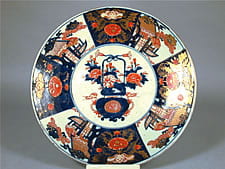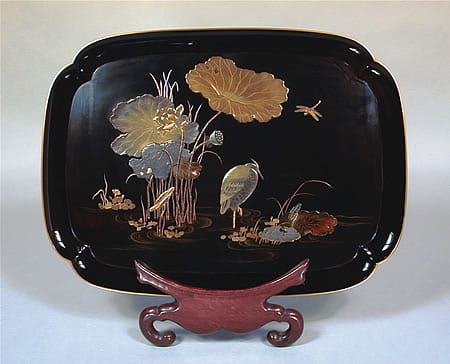Splendor and Simplicity: An Introduction to Japanese Artistic Style
September 8, 2006 – April 1, 2007
USC Pacific Asia Museum to Open New Gallery Dedicated to Japanese Art First Exhibition
PASADENA, CA — On September 8, 2006, USC Pacific Asia Museum debuts a new gallery devoted to Japanese art. The gallery’s inaugural exhibition Splendor and Simplicityexplores the many facets of Japanese aesthetics – from the austere to the playful, from the simple to the spectacular – challenging the assumption that there is only one Japanese artistic style.
Aesthetics reflect cultural values and in Splendor and Simplicity visitors are presented with several aspects of culture in Japanese art from the simplest tea bowls to the most sumptuous kimono. The austere beauty of wabi is strongly tied to the tea ceremony, which has its roots in Shinto, Zen, and samurai culture. Miyabi, a more elegant, courtly aesthetic, appears in lacquer wares such as an exquisite tray decorated with a heron and lotus and in women’s calligraphy. Kabi, a sumptuous, flamboyant aesthetic exported widely to the West, is apparent in many woodblock prints and in Imari porcelains. Finally, the playful, humorous mood, asobi, is found in many Zen paintings and works of folk art.
The new Gallery of Japanese Art will feature paintings, prints, textiles, ceramics, lacquer wares, and netsuke from the museum’s renowned collection, and is scheduled to rotate periodically in thematic displays. Highlights of the new 498 sq. ft. gallery include a traditionaltatami mat area with an alcove (tokonoma) used for displays of paintings, calligraphy scrolls and floral arrangements as they would be shown in a traditional Japanese home, temple, or tea room. Another key feature is the rare 15th -century Buddhist temple ceiling donated to USC Pacific Asia Museum especially for this gallery. The unveiling of the Gallery of Japanese Art marks the beginning of a larger multi-year initiative to re-install the museum’s collections in more informative and relevant ways for the community.
“A museum has no greater responsibility to its donors and the public than to adequately preserve and care for its collection, and the beautiful new Gallery of Japanese Art will allow us to show more of our collection in rotating exhibitions,” said Joan Marshall, Executive Director of USC Pacific Asia Museum. “We have an amazingly rich collection and we want to share it with the public.”
The new gallery incorporates elements from traditional Japanese buildings, including sliding doors and decorative transoms (ranma).
“Our goal was to create an authentic sense of place and an environment where our visitors can truly engage with the art,” said Meher McArthur, Curator of East Asian Art at USC Pacific Asia Museum.
The Gallery of Japanese Art has been made possible by the generous support of the E. Rhodes and Leona B. Carpenter Foundation, Toshie and Frank Mosher, the National Endowment for the Arts, and Setsuko Oka.


USC Pacific Asia Museum’s collection of Japanese art has grown to over 4,000 works of art-more than one third of the entire permanent collection. It includes paintings, drawings, woodblock prints, textiles, costumes, ceramics, lacquer wares, ivories, metalwork, folk toys, furniture, and Buddhist and Shinto sculptures. Over the last two years, we have been planning a beautiful new Gallery of Japanese Art that will allow us to show more of our collection in rotating exhibitions.
The new gallery’s display cases, door and wall details will feature elements of traditional Japanese architecture. It will also contain a small tatami-mat area with an alcove (tokonoma) where we will display paintings, calligraphy scrolls, and flower arrangements as they would be shown in a traditional Japanese home, temple, or tea room. A spectacular feature of this gallery will be the permanent installation of a 15th-century Buddhist temple ceiling-the first of its kind in a West Coast museum, thanks to the generosity of donor Tom Grayson. Truly a rare sight outside of Japan, the temple ceiling will provide a more rich context in which gallery visitors can appreciate the art.
The Gallery of Japanese Art will open to museum members on Thursday, September 7 (and opens to the public the following day, Friday, September 8). The first installation will focus on traditional Japanese aesthetics, demonstrating the variety of aesthetic styles in Japanese art. The simple, humble aesthetic is often referred to as wabi and is well represented by a ceramic sake bottle from the kilns of Bizen.
This aesthetic is strongly tied to the tea ceremony, which has its roots in Shinto, Zen, and samurai culture. Miyabi, a more elegant, courtly aesthetic, is exemplified in lacquer wares such as an exquisite tray decorated with a heron and lotuses and in the ethereal calligraphy produced by the Buddhist nun, Otagaki Rengetsu. Kabi, a sumptuous, flamboyant aesthetic enjoyed by the townspeople and exported widely to the West, is apparent in woodblock prints and in Imari porcelains such as a dish decorated with vivid enamels. Finally, the playful, humorous sensibility, asobi, can be observed in many Zen paintings, folk art objects, and in netsuke such as a carved ivory example of the Chinese Immortal, Gama Sennin riding a toad.
We are extremely excited to be opening this fabulous new home for our outstanding collection of Japanese art.
The Gallery of Japanese Art has been made possible by the generous support of the E. Rhodes and Leona B. Carpenter Foundation, Toshie and Frank Mosher, the National Endowment for the Arts, and Setsuko Oka. Support for future installations in the Gallery for Japanese Art can be arranged by contacting David Spiro at ext. 28.
Meher McArthur
Curator of East Asian Art
